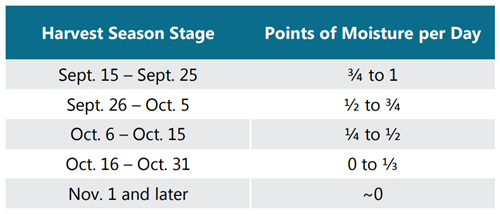Written by: Taylor Knott, Certified Crop Advisor with Sprucedale Agromart
Looking back at the 2023 growing season, we’ve been on a weather rollercoaster from the time the first seeds went in the ground this spring…but isn’t that the story every year. From dry planting conditions to an abundant amount of moisture through the summer months, many growers were not sure what they should expect by combine time. What many did not expect would be how far behind they felt their corn crop was when we started pulling open husks looking for dented kernels, assessing milk lines and finally searching for black layer.
There are multiple assumptions about why we are looking at the calendar and feeling that corn harvest had been delayed before it had even begun. First and foremost, corn planting was late this spring, only getting started around the 10th of May and not having many plants out of the ground until May 23-24th which is some of the latest we’ve seen. Secondly, the wildfire smoke that filled the skies multiple times throughout the early summer has raised questions about how the lack of direct sunlight would impact our crops. According to researchers at both Perdue University and Iowa State, the two biggest concerns from the smoke were a reduction in photosynthesis due to the reduced sunlight available to the plants, and the creation of ozone when air pollutants emitted from the wildfire react with sunlight; this can cause harm to plant tissue and further reduce photosynthesis. The conclusion was that wildfire smoke is more damaging to the corn crop during grain fill and that little to no yield loss is expected due to the smoke we experienced. Continuing through the season; the summer months were slightly cooler than previous years, rarely reaching 30°C through July and August when we typically accumulate the bulk of the Growing Degree Days (GDD). Luckily, September brought with it some warmer days, helping to encourage the corn crop towards maturity before the first frost that spread across the county on October 23rd.
Even though there is nothing we can do to control the weather patterns during the season, we can at least understand how the plants are maturing and how much we can expect grain moistures to change week to week. It was the end of August before we were consistently finding dented kernels (R5) and a general rule of thumb is that it will take 7-10 days to mature between each stage on the image above. Once we hit physiological maturity (R6) and can find black layer, the moisture of the grain will range from 30-35% and further dry down is all based on moisture evaporating from the kernels.
The rate of dry down is very closely associated with the GDD that continue to accumulate towards the end of the season. When the weather is more favourable in mid to late September the grain can dry down as much as one point per day, allowing early maturing varieties to make use of these warmer days and dry down faster. Full season varieties that do not black layer until later in the fall may only dry down ¼ to ½ point per day once the weather starts to turn cooler, and thus take longer to reach moistures we would like to see through the combine.
As we’re approaching buying seed for another kick at the can in 2024, it is important to keep in mind how our corn crops finished off the season this year.
- Were the plants showing signs of nutrient deficiency by the end of the season?
- Was there a significant amount of disease on the leaves that would sacrifice yield?
- Was the corn maturity in line with your heat unit range or was it pushing the envelope?
Make sure to build off the nuances that affected our 2023 crop and strive to do better by scaling up each area of our varying production systems for the highest yields yet in 2024.

